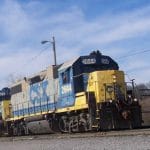FOX5NY reports that 103 people were injured when Long Island Rail Road (LIRR) train 2817 derailed at the Atlantic Terminal in Brooklyn, N.Y. at 8:20 a.m.
The first train car left the track, but no other cars seemed to have derailed. Approximately 600 passengers were on the train at the time of derailment.
Click here to read more from FOX5NY.
Tag: derailment
Two CSX trains collided in Marion County, Fla. in the early hours of Wednesday, Nov. 16, causing approximately 20 train cars to derail. Two members of the train crews were treated for injuries and released without hospitalization. An estimated 15,000 gallons of fuel was spilled.
Click here to read more from Florida Today.

Possible environmental concerns arose regarding the Columbia River, as a light oil sheen can be seen floating on the river’s surface.
Read the complete article here.

The train originated from North Dakota and was carrying the volatile Bakken crude oil to Washington state. Eleven of the 96-car train derailed almost 70 miles east of Portland, near the town of Mosier, Ore.
SMART TD Washington State Legislative Director Herb Krohn has been briefed on the accident and was dispatched to the scene. Krohn serves on the Transportation Division Rail Safety Task Force.
Click here to see pictures of the derailment from RT news.
Click here to read more from The Oregonian.

The derailment caused eight people to lose their lives and over 200 injuries. The NTSB found that “the probable cause of the accident was the engineer’s acceleration to 106 miles per hour as he entered a curve with a 50 mile per hour speed restriction, due to his loss of situational awareness likely because his attention was diverted to an emergency situation with another train. Contributing to the accident was the lack of a positive train control (PTC) system. Contributing to the severity of the injuries was the inadequate requirements for occupant protection in the event of a train overturning.”
The NTSB also made numerous recommendations to the Federal Railroad Administration (FRA), Amtrak, American Public Transportation Association (APTA), Association of American Railroads (AAR), Philadelphia first responders, Philadelphia’s mayor and National first responders organizations based on the accident and their findings.
The NTSB recommended to the FRA that they consider requiring railroads to install procedures where no PTC is present; modify existing regulations to include the number of crewmembers required in the cab of the locomotive and use the data regarding the number of crewmembers in the controlling cab of the train at the time of an accident to evaluate safety adequacy of current crew size regulations; and conduct research to evaluate the causes of passenger injuries and evaluate methods for mitigating those injuries such as the use of seat belts and implement any findings.
The NTSB recommended to Amtrak that they incorporate training strategies for operating crewmembers and new hires to recognize and effectively manage multiple concurrent tasks in prolonged, atypical situations.
Click here to read a summary of the NTSB’s findings.
Click here to read NTSB Chairman Christopher Hart’s opening statement.
Click here to read the presentation given by the NTSB.
Click here to read Hart’s closing statement.
Click here to view the webcast.


Read the complete story here.

Cargo included flammable liquid that ignited upon impact, forcing the evacuation of hundreds of nearby residents. Investigators noted that the fire could have been much worse.
Read the complete story here.

Click here to read the entire article.